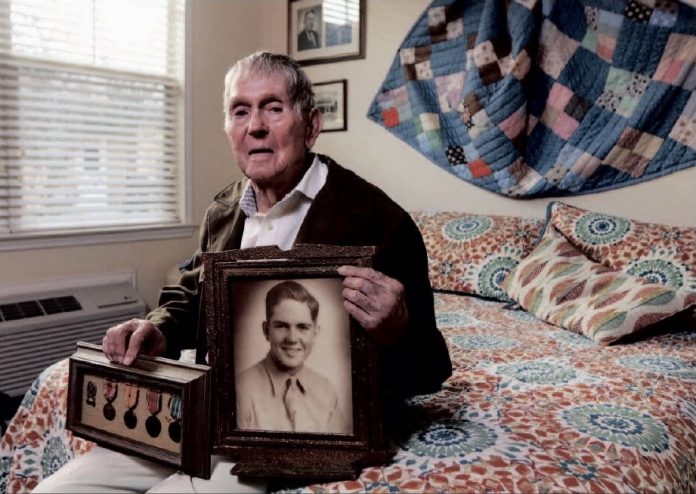
BY RALPH LITTLE
Special to the Odessa American
EDITOR’S NOTE: Ralph Little is a retired Army officer in Jacksonville, Fla., who wrote this piece about longtime Odessan Richard Owens. Little is the son of the man who was the weapons platoon leader in Richard’s company during World War II.
Little said he found Richard by chance through the 91st Infantry Division League.
Fort Worth native and longtime Odessa resident Richard Preston Owens fought in World War II as a rifleman with the 91st Infantry Division in northern Italy.
A roster acquired from the National Archives during research for a book Little is writing lists Richard. That roster was prepared as testimony to the company’s role in a significant battle.
As with many WWII events this year, Sept. 20 was the 75th anniversary of that battle and Oct. 16 was Richard’s 94th birthday. He may also be the last living member of that company.
Private Owens’ first taste of battle at age 18 was in July 1944 as his infantry unit, I Company, 3rd Battalion, 362nd Infantry Regiment, pushed the German infantry, Panzers and deadly 88mm guns across the Arno River in Tuscany. They would then patrol and prepare for a rivercrossing for over a month.
For most of that time it was an infantryman’s bad dream as American and German patrols mixed it up in a large No Man’s Land full of mines, pot shots by snipers and artillery harassment. After British forces near Florence made a breakthrough,
following rolling barrages to clear multiple strong pillboxes. Their reward for success was two days of climbing Mt. Gazzaro, the steep mountain above them, with Richard and the others using ropes to lift their tired selves, weapons and supplies.
The company was allowed to rest on the 24th after 12 days with little food or sleep. They were glad for both, as well as a shower and clean uniform.
Testimony to the severity of combat, the men of 3rd Battalion earned at least 39 Silver Stars for gallantry in action during those 12 days – nearly 10 percent of the 91st Division’s total for WWII. Ten of those awards went to I Company with eight being earned during the height of the Big Fight on 19-20 September.
As an aside, Little emailed that he is working with Richard Owens to fill out paperwork so that Owens will receive a couple of relevant awards.
Little details that the WWII regulation for a Combat Infantry Badge required the recipient to be an infantryman and be exposed to combat with an enemy. Richard qualifi ed for the CIB soon after he arrived in I Company in late July 1944 and spent six months in combat. The 91st Infantry Division adjutant collected names and published a list on 18 October 1944 of those qualified for the CIB. Unfortunately, Richard’s entry was twice flawed – his middle initial was given as “R” instead of “P” and the second digit of his Serial Number was shown as a “5” rather than the correct “8”.
the Arno was crossed at Florence in early September. The 91st then approached the Apennine Mountains where the Germans had built their most heavily fortified defensive position, the Gothic Line, spanning the entire Italian peninsula.
By the 12th, and by design, Richard’s battalion found itself inching up Highway 65 to convince the Germans that the main attack on their line would follow that road north through the mountains.
Richard’s own term for the next dozen days was “the big fight.” That the road through the Futa Pass was the best and shortest way to the rich Po River Valley helped the rationale. The other two battalions of the 362nd Regiment had taken heavy casualties and the regimental commander chose to move I Company to help another battalion.
As Richard recalls, they had just dug in for the night when told to move.
What followed was a five hour jostling truck ride to their new fight.
They would dismount only to be pinned down by all manner of bullets and shelling for nearly a day.
Once the firing subdued, the company made its way up steadily rising terrain.
After close-quarters combat and multiple attacks the infantry managed to push the defending German paratroopers out of the area around the fortified hamlet. Not finished, they had to reform and attack across open ground The second digit of WWII Serial Numbers referred to groups of states (2-4 in a group) from which the soldier was resident. An “8” would have included Texas, while the “5” was in the area of Indiana. Being from Fort Worth, Richard could only have been an “8”. Richard does not remember receiving the badge, however, he likely did since he remembers it being lost.
Richard likely received his CIB in October 1944.
Little said if you flip forward 75 years and through archives research, he already had three official rosters showing Richard’s correct name and Serial Number. Two years of research allows him to verify that I Company only had one Richard Owens. To mark his 2019 Veterans Day, Little acquired a 1944 badge and sent it to him.
In 1947, two years after Richard left the service, the War Department and Army authorized CIB recipients to be awarded the Bronze Star Medal if they apply for it. Together Little and Richard prepared an application accompanied by two of his discharge documents.
Little writes: “The bottom line is that soldiers do fight for each other. In our case, Richard is connected to my father and all three of us earned CIBs, although mine was in a different war and 28 years after theirs. I don’t know if our effort will be successful, but we are certainly trying to acquire Richard’s deserved medal and perhaps official recognition of his Combat Infantry Badge.”



